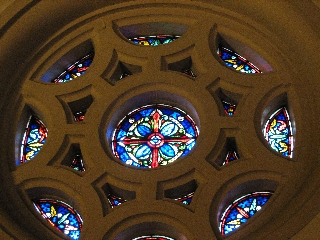
The Rose Window
This year while attending the Celebration of the Arts, May 1-2, at the Church of the Brethren in downtown La Verne, take a while to also appreciate the church’s unique art and architecture. From its welcoming gates and courtyard to the pulpit and chancel, the church is a sanctuary of symbolism inviting your discovery and reflection.
Richly Romanesque and Gothic, surprising for a Brethren structure, the church may have no artistic or architectural equal in the city of La Verne.
Also, in your Celebration of the Arts wanderings, should you see Barbara Smythe, a charming woman and relative newcomer to the church, tug at her coat sleeves and prevail upon her to share some of the church’s symbolic secrets that she too has only recently discovered.
“I was fascinated and surprised by all the symbols I saw,” said Smythe, who became a member of the church in 2001, about the same time as the Twin Towers came down on Sept. 11. “I would ask people in the congregation about some of the art objects and art symbols, but most were unaware of the symbolism.”
A retired educator and administrator with a lifelong love of learning, the naturally curious and inquisitive Smythe slowly began researching both the city’s and church’s history, as well as the memories and recollections of church members, which culminated in the 2008 publication of her book, “La Verne Church of the Brethren: A Guide to Its Art and Architecture.”
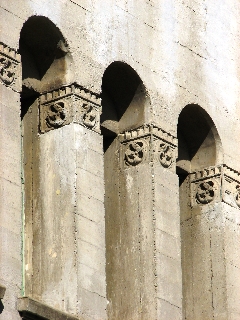
Romanesque arched windows
The Brethren are exceedingly humble, so Smythe would be the first to describe the book as a collaborative effort that could not have been completed without the contributions of photographer Elaine Zukle, layout designer and church historian Marlin Heckman, historian Galen Beery, artists Joe Cahill, Bernice Pence and Eric Davis, advisors Al Clark and Dorothy Davis and Pastor Susan Boyer.
In her quest, it didn’t take Smythe long to discover that the Church of the Brethren’s current structure is something of a miracle. Construction began October 1929, the same month as the stock market crash, which triggered the Great Depression. At first, church members didn’t believe the economic crash would seriously threaten the orange industry on which so many parishioners were dependent for their livelihoods. But as the price of oranges dropped from $3.40 a box to $.50 a box, they knew better.
Agonizing over how to pay for the structure that it had committed to build, the congregation decided to borrow $41,000 and pare back the scale of the project. Plans for a portico were shelved and the size of the church tower was cut by 14 feet. Thirteen years later after countless fundraising dinners and sales of tiny teabag-size sacks of cement, the debt was finally paid, with the bonds of indebtedness ceremoniously burned on the first Sunday of December 1943.
Mysteriously, more is known about the funding of the project than the project itself. While Robert H. Orr, a Los Angeles architect, was hired to design the project, little, according to Smythe, was actually written about how the Brethren Church came to incorporate so many different and fascinating religious symbols typically associated with more ostentatious Christian faiths and denominations. For example, the La Verne Church of the Brethren, founded in the city in 1890, did not own or condone the use of a piano in its sanctuary until 1923.
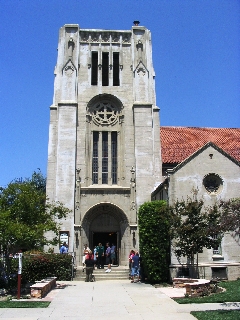
A towering presence
The symbols are there nonetheless, and Smythe, like Robert Langdon in the Da Vinci Code, using her powers of investigation and inference, has tried to help decipher them.
In her book, Smythe notes there are four principal symbols found throughout the fabric of the church: quatrefoils, circles, reversed Ss (yin-yang symbols) and leaves and vines (both Grape and Acanthus).
By far the most prevalent symbol in the church, found on the walls, furniture windows, woodworks, and fixtures, is the quatrefoil composed of four half circles forming what looks like a representation of a flower with four petals or a leaf with four leaflets. The quatrefoil is traditionally used as a symbol of the four Evangelists – Matthew, Mark, Luke and John.
Circles are ubiquitous as well, reflecting the nature of eternity. Christian hope is predicated on being resurrected into heaven to live forever.
While Smythe found the quatrefoils to be the most prevalent, she found the Reversed S or Yin-Yan symbols to be the most perplexing because of their oriental origins. In Chinese culture, this symbol represents the dichotomy of opposites – complementary rather than opposing, existing in a circle of unity and inclusion. “All forces in nature,” Smythe writes, “can be seen as having ying and yang states, such as male and female, light and dark, fire and water. The yin-yang symbol represents a unity of opposites, a concept embraced by the La Verne Church of the Brethren. This imagery is found on the church tower and along the exterior roof-line of Fellowship Hall.”
Finally, vines and leaf patterns curl and cluster around pillars and wrought iron and are found both inside and outside the sanctuary. The grape vine is a symbol of blessing and fertility, as Smythe affirms with quotes from several Biblical passages: “Israel will grow as the vine” (Hosea 14:8); “Thy wife shall be as a fruitful vine” (Psalm 128:3). Christ described himself as the true vine and his father as the vinedresser (John 15:1-2), she writes.
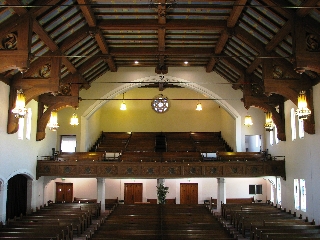
The heavily beamed sanctuary
Walking into the sanctuary, you can’t help but notice the quatrefoils that appear on the woodwork of the pews. The ceiling and support beams overhead seem to echo the lavish use of wood.
“The support beams are actually made of concrete and were painted to look like wood grain,” Smythe revealed.
In 1930, the church also installed a magnificent Kilgen pipe organ, which is concealed by a massive wrought iron screen, “by far … the most obvious decorative piece in the sanctuary,” Smythe writes.
“It was unheard of,” Smythe added, “to go from no musical instrument at all to a pipe organ.”
Above the screen is a pierced metal panel depicting three biblical musical events: David playing the harp for Saul; the angels singing at the birth of Christ; and people singing Hosanna in praise of Christ’s triumphant entry into Jerusalem on Palm Sunday.
When Smythe was new to the church, she admired the painting behind the baptistery (the Brethren believe in adult baptism), showing a river, which she believed was the Jordan River, where Christ was baptized by John the Baptist.
“But I thought it odd that there was a pedestrian bridge,” Smythe said. “I later found out the river was Wissahickon Creek near Germantown, Pa., where the first Brethren baptisms in America were conducted.”
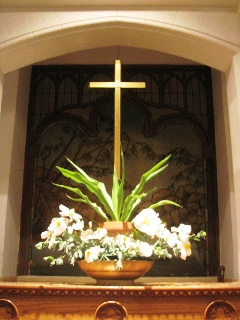 Smythe further notes that painted above the scenic landscape is a grillwork of three half-circles forming an arch over the scene.
Smythe further notes that painted above the scenic landscape is a grillwork of three half-circles forming an arch over the scene.
“Whether it is merely decorative or a representation of the trinity is unknown,” Smythe said.
Many unknowns remain about the church’s art and architecture because the architect and builder left behind few records or notes detailing the building’s design and construction. Consequently, parishioners and visitors, often impose their own interpretations to fill the void.
While mysteries remain, beauty abounds, and, perhaps, no more so than in the church’s ubiquitous stained glass windows. Those in the sanctuary crafted by Judson Studios of Highland Park “live gloriously in the sun and die beautifully with the darkness.” The crown jewel in the sanctuary is the “rose window,” a term Smythe notes was probably taken from the Old French word “roué,” meaning wheel, not from the English flower name, rose. As for the rose window, architect Orr did leave this description in a La Verne Leader newspaper article from September 18, 1930: “To really appreciate this window, the observer must notice it under all the various intensities of light produced by the sun. Hardly for a period of longer than 10 minutes at a time does the window have the same color.”
In the East Room of the sanctuary, there are many more stained glass windows to explore, and in the Administrative Building, there are 17 additional stained glass windows designed and fabricated by current designer Bernice Pence and stained glass artist E. Joseph Cahill. Eleven of the windows depict biblical stories, ordinances of the Church of the Brethren, and a significant 18th century Brethren leader, Alexander Mack.
The Mack window — featuring a cross, heart, fruit symbols and Mack’s initials, A.M. — represents the Mack Seal, which portrays the Brethren ideal of sacrifice, fruit bearing and a life of devotion.
The window also contains an Easter egg (a hidden joy or serendipitous discovery) that Smythe became privy to and shared with readers:
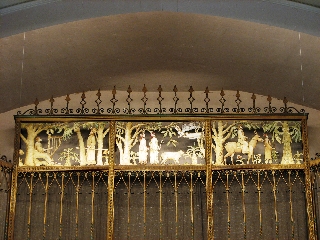
Pictorial panel at the top of the pipe organ screen
“Joe Cahill revealed in conversation that he did Alexander Mack’s initials in block letters so that they would not look strange from the outside. He was successful. The letters do not look strange, but from the outside they read, ‘M.A.’ His mother’s name is Mary Alice and, in one of those moments of wanting to please your mother, he told her he had done the window for her. He did tell her the truth later, but the story of the Alexander Mack initials is a favorite, and until now secretly shared story in the Cahill family.”
The Church of the Brethren is full of such treasures and anecdotal material. The most recent addition is the wrought iron gate at the southeast corner of the courtyard completed by artist Eric Davis and dedicated to the memory of Frank R. Johnson, a devoted member of the church who also served La Verne for 20 years as either a council member or mayor. Shaped from the wrought iron are tulips, one of Johnson’s favorite flowers, and a citrus tree, symbolic of both Johnson’s and the City’s long involvement in the citrus industry.
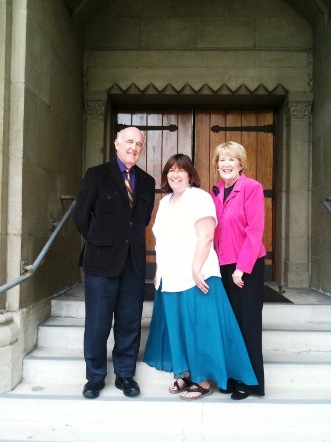
Marlin Heckman, Susan Boyer and Barbara Smythe stand on the steps leading into the sanctuary.
Fittingly, the gate’s most dominant feature is a large mahogany quatrefoil, the center of which appears to contain the Greek cross with arms of equal length, said to represent the union of divinity (the vertical line), and the world (the horizontal line).
“The church isn’t static and neither is its artwork,” Smythe said, concluding her tour with as much passion and vigor as when she started it. “Parishioners still want to add to the beauty and bring their own talents and designs. It is a living organism, interconnected with those who worship here.”
Whenever you visit, be it during the Celebration of the Arts, May 1-2, or some other time, take time to experience the beauty surrounding you, Smythe urged.
“Allow the silent language of the images to wash over you and awaken your soul and spirit.”
Copies of the book are available from the Church office, 9 a.m. to noon and 1 p.m. to 4 p.m., Monday through Friday, for $12.



April 26th, 2010 at 6:12 am
Thank you for a very interesting article and a look into the history of La Verne.